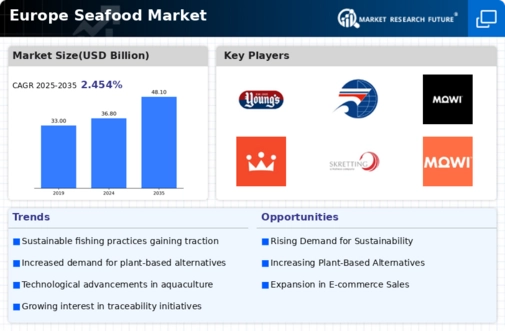The Europe Seafood Market is characterized by intense competition, driven by a growing consumer demand for high-quality, sustainable seafood products. With increasing health consciousness among consumers, the market has witnessed a shift toward fish and seafood as preferred sources of protein. Rising awareness regarding the health benefits of seafood, along with a shift towards more innovative and convenient product offerings, has prompted seafood companies to enhance their supply chain and production processes. The market dynamic is shaped by fluctuations in supply due to environmental factors, regulatory frameworks, and sustainability concerns, prompting companies to adapt their strategies accordingly.
The competitive landscape is populated by a mixture of large multinational players and smaller niche brands, each striving to distinguish themselves through quality, sustainability, and value-added products, making the a vibrant and evolving sector.Young's Seafood holds a prominent position in the , recognized for its strong brand identity and commitment to sustainability. The company is particularly noted for its wide range of frozen and chilled seafood products, which cater to diverse consumer preferences while maintaining high quality standards. Young's Seafood has effectively capitalized on the increasing demand for convenient meal solutions, offering ready-to-cook options that align with contemporary cooking trends.
Its strong distribution network across various European countries, both through retail and food service channels, enhances market reach and strengthens customer loyalty. Furthermore, Young's Seafood emphasizes responsible fishing practices, reinforcing its brand ethos and responding to the growing consumer demand for environmentally sustainable products. This commitment to sustainability has positioned the company favorably within the competitive landscape, allowing it to maintain its relevance amidst a shifting marketplace.Austevoll Seafood also plays a significant role within the , known for its vertically integrated operations that encompass fishing, processing, and distribution.
The company offers a diverse range of seafood products, including pelagic fish, which are increasingly popular among European consumers for their health benefits and culinary versatility. Austevoll Seafood has established a substantial market presence, supported by strategic acquisitions that have expanded its capacity and product portfolio. Its commitment to high-quality seafood and sustainable fishing practices fortifies its competitive edge, enabling it to cater to both the retail and food service industries effectively. The company's focus on innovation, particularly in product development and processing technology, further enhances its ability to meet evolving consumer demands.
Austevoll Seafood's position as a responsible player in the seafood sector is bolstered by its active engagement in sustainability initiatives and compliance with regulatory standards, which resonate with the growing consumer emphasis on ethical sourcing.



















Leave a Comment